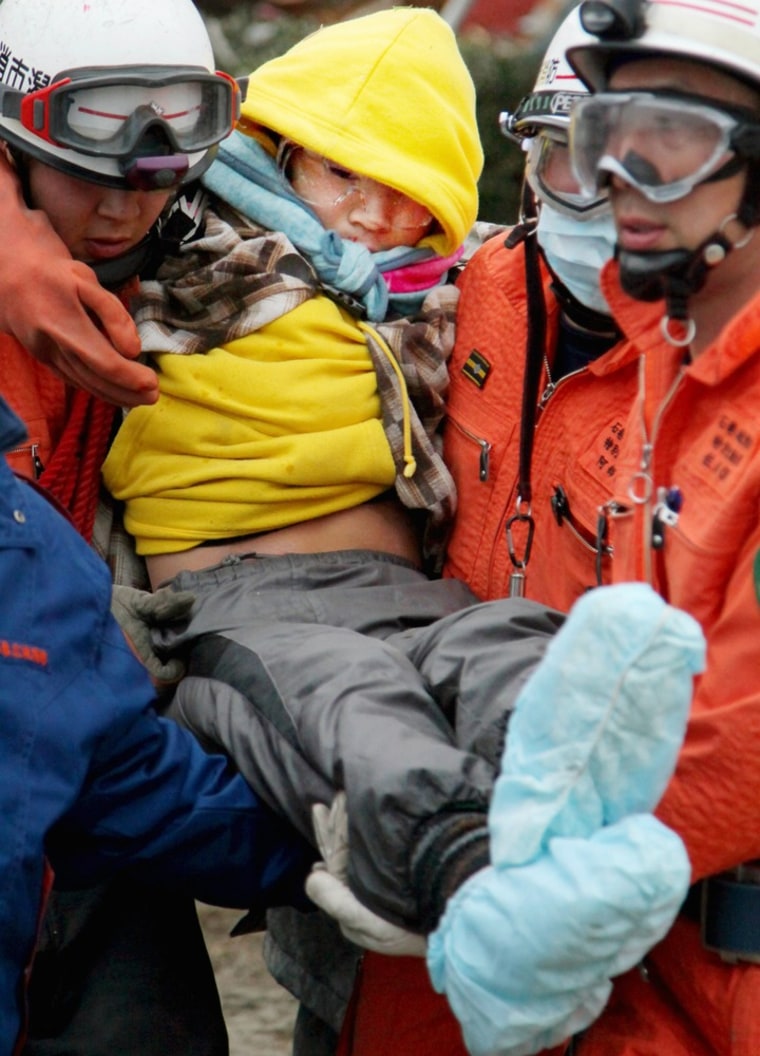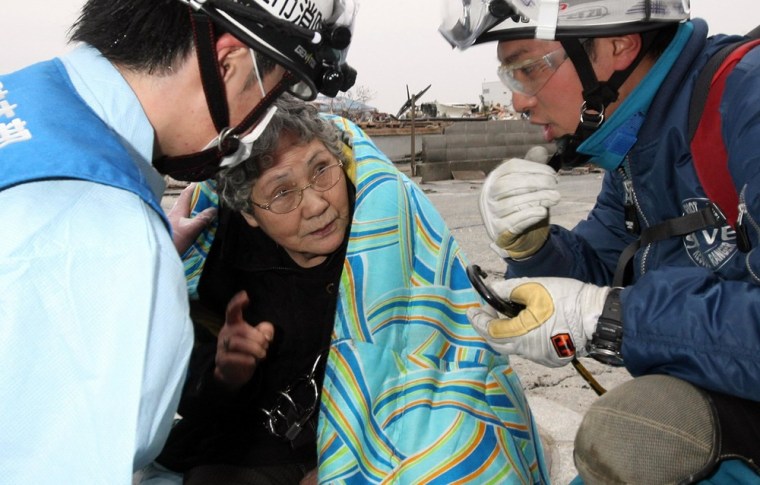The voice rang out suddenly, unexpectedly, from the wreckage left behind by the monstrous earthquake and tsunami that ripped through the country's northeast nine days ago.
"Please help! Please help!"
There, on the roof of his collapsed wooden home, stood a shivering Jin Abe, so cold that he had draped layers of towels around his body. His grandmother, Sumi Abe, was trapped inside, too, the 16-year-old told the team of Ishinomaki police officers who had been patrolling the hard-hit city on Sunday.

The two had been stuck there since the March 11 magnitude-9.0 quake struck off the coast of Japan, triggering a massive tsunami that obliterated much of the northeastern coastline. Their neighborhood, too, lay in ruins.
The 80-year-old woman's weak legs kept her from walking, and the teenager had been unable until Sunday to crawl out of the wreckage, police spokesman Shizuo Kawamura said.
Police called in personnel with better equipment to help rescue the woman, whom police found wrapped in several blankets, on top of a collapsed closet.
Grandmother and grandson were weak but conscious, having survived on the food they had in their refrigerator, Kawamura told The Associated Press by telephone. The earthquake and tsunami knocked out power and telephone service throughout the northeast coast.
National broadcaster NHK aired dramatic video of the rescue, which showed a stunned, though coherent, woman. She gave her name when asked.
"Are you hurt?" a rescuer said.
"No," she replied, and asked about her grandson.
Both she and Jin were taken to a nearby hospital.
A couple days after the disaster, an aunt asked police to search for the two. On Sunday, Jin's father, Akira Abe, told reporters gathered at the hospital that he had never given up hope.
"I always believed they were alive," he said.
The rescue offered Japan an uplifting piece of news amid colossal devastation and sadness with thousands of dead and missing. Still, Kawamura said he wasn't smiling.
"We have too many other victims to find to take the time to celebrate," he said.
The rare good news punctuated the traumatic hunt for bodies and missing people.
"This morning my next door neighbor came crying to me that she still can't find her husband. All I could tell her was, 'We'll do our best, so just hold on a little longer,'" fire brigade officer Takao Sato in the disaster zone said.
About 257,000 households in the north still have no electricity and at least 1 million lack running water. Food, water, medicine and fuel are short in some parts, and low temperatures during Japan's winter are not helping.
Race to avert disaster
Meanwhile, Japan made some progress in its race to avert disaster at a nuclear power plant leaking radiation after an earthquake and tsunami that are estimated to have killed more than 15,000 people in one prefecture alone.
Three hundred engineers have been battling inside the danger zone to salvage the six-reactor Fukushima plant in the world's worst nuclear crisis since Chernobyl 25 years ago.
"I think the situation is improving step by step," Deputy Chief Cabinet Secretary Tetsuro Fukuyama told a news conference.
But rising cases of contaminated vegetables, dust and water have raised new fears and the government said it will decide by Monday on whether to restrict consumption and shipments of food from the quake zone.
Food beyond Japan's borders was also reportedly tainted. Radiation was detected on fava beans imported from Japan to Taiwan, Taiwanese officials said in what appears to be the first case of contamination in Japanese imports.
Taiwan's Cabinet-level Atomic Energy Council Radiation Monitoring Center said in a statement that a small amount of iodine and cesium had been found on a batch of Japanese fava beans imported to the island on Friday. The center said 11 becquerels of iodine and 1 becquerel of cesium were detected.
Higher death toll
Police said they believed more than 15,000 people had been killed by the double disaster in Miyagi prefecture, one of four that took the brunt of the tsunami damage. In total, more than 20,000 are dead or missing, police said.
The unprecedented crisis will cost the world's third largest economy as much as $248 billion and require Japan's biggest reconstruction push since post-World War Two.
It has also set back nuclear power plans the world over.
Encouragingly for Japanese transfixed on work at the Fukushima complex, the most critical reactor — No. 3, which contains highly toxic plutonium — stabilized after fire trucks doused it for hours with hundreds of tones of water.
"We believe the water is having a cooling effect," an official of plant operator Tokyo Electric Power Co (TEPCO) said.
Work also advanced on bringing power back to water pumps used to cool overheating nuclear fuel, and temperatures at spent fuel pools in reactors No. 5 and 6 were returning to normal.
Technicians attached a power cable to Nos. 1, 2, 5 and 6 reactors, hoping to restore electricity later in the day prior to an attempt to switch the pumps on.
They aim to reach No. 4 on Monday or Tuesday.
Drastic measures
If successful, that could be a turning point in a crisis rated as bad as America's 1979 Three Mile Island accident.
If not, drastic measures may be required such as burying the plant in sand and concrete, as happened at Chernobyl in 1986, though experts warn that could take many months and the fuel had to be cooled first.
On the negative side, evidence has begun emerging of radiation leaks from the plant, including into food and water.
Though public fear of radiation runs deep, and anxiety has spread as far as the Pacific-facing side of the United States, Japanese officials say levels so far are not alarming.
Traces exceeding national safety standards were, though, found in milk from a farm about 18 miles from the plant and spinach grown in neighboring Ibaraki prefecture.
The government ordered additional tests and depending on the results may ban sales and shipments of food products from areas in the vicinity of the plant.
The discovery of contaminated food since the March 11 disaster is likely to heighten scrutiny of Japanese food exports, especially in Asia, their biggest market.
Tiny levels of radioactive iodine have also been found in tap water in Tokyo, about 150 milesto south. Many tourists and expatriates have already left and residents are generally staying indoors.
Harmless levels of iodine and cesium were also found in northern Ibaraki and in dust and particles in the greater Tokyo area, the government said on Sunday.
The fresh reports did not appear to have much effect on people in the metropolis, one of the world's biggest cities with a population of about 13 million.
"I think we need to monitor it, but I am not going to stop eating vegetables today," said Andy Ross, an American buying vegetables at a store in Tokyo.
But Physicians for Social Responsibility, a U.S. non-profit advocacy group, called for a halt to new nuclear reactors in the United States.
"There is no safe level of radiation exposure," said Jeff Patterson, a former president of the group.
